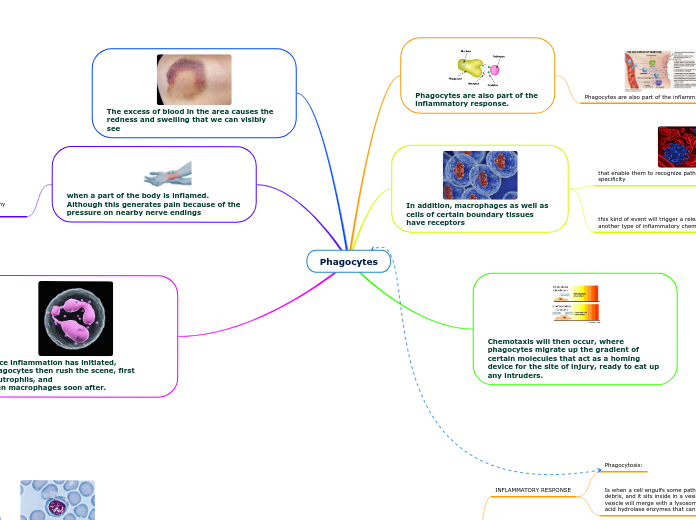Adaptive Immune System
PRIMARY IMMUNE RESPONSE
Massive production of antibodies
that recognized the antigen
Naturally
Infection
Artificially
Vaccines
HUMORAL INMUNE RESPONSE
B cell encounters its antigen
Causes endocytosis
proliferatioan and differentiation
into plasma cells
THE IMMUNE SYSTEM
Adaptive Defense System
antigenic
determinant
The part of the foreign substance that interacts with the immune system
Antigens:
These can be proteins, polysaccharides, lipids.
''antibody generating''refers
to any foreign substance that will be recognized as being not of the self, and will thus provoke
an adaptive immune response
cells
T cells that fail to do this are forced to undergo apoptosis
Undergo activation and differentiation
when Tcell antigen receptors interact
with antigen-presenting cells
Proliferation and defferentiation
Resulting T cells can be a wild variety
Co-stimulation must occur from other molecules
on the surface of the antigen-presenting cells
MAJOR TYPES
CD8
Destroy foreign cells or body cells with foreign agents
CD4
Activate B cells, Tcells and macrophages
Kill cells that have been infected
by viruses or vacteria as well as
cancer cells.
B cells these receptors are actually membrane-bound antibodies
pathogens
they are able to mark such that phagocytes
can recognize them for destruction
antibody or lymphocyte
These are large Y-shaped proteins that are produced by lymphocytes, and they circulate
in the blood and lymph
will bind in a way that resembles enzyme-substrate interactions,and different lymphocytes will recognize different determinants.
These include B lymphocytes or T lymphocytes, depending on what type of immunity they oversee,
and there are also antigen-presenting cells
these are large proteins, and they consist of four polypeptide chains connected by disulfide bridges.
There are five classes of antibody, listed here, where Ig stands for immunoglobulin, another name for antibody, followed by M, A, D, G, or E. These have different roles and locations.
The two halves of the Y shape are identical. There are two heavy chains, and two light chains, and a hinge region where the kink occurs.
shape depending on which antigen it will recognize, and this region is at the tip of the Y arms, which we call the antigen-binding site.
Some of these are monomers, some are dimers, some are even pentamers, depending on how many antibodies come together.
Lymphocytes
A particular antigen, thousands of surface receptors are
produced that are devoted to that recognition.
Originate inside red bone marrow, from hematopoietic stem cells.
Innate Defense System
This separates what’s inside from what’s outside, but of course, there are lots ofways for pathogens to get past this barrier.
Mucosae: They tend to be acidic, which inhibits bacterial growth. Many of them have lysozymes, which destroy bacteria.
Skin: These are very effective at blocking pathogens from entering the body. Is easily get infections when we have cuts on the skin, because pathogens.
It begins with external membranes, like the skin and a variety of mucous membranes.
INFLAMMATORY RESPONSE
Is when a cell engulfs some pathogen or other debris, and it sits inside in a vesicle. This vesicle will merge with a lysosome, which has acid hydrolase enzymes that can digest.
These pieces then leave the cell by exocytosis, unable to do any harm. The biggest and best phagocytes are macrophages, which are derived from white blood cells.
Phagocytosis:
Phagocytes
Once inflammation has initiated, phagocytes then rush the scene, first neutrophils, and
then macrophages soon after.
In diapedesis, they squeeze out of the capillary.
This begins when phagocytes enter the bloodstream from the red bone marrow, so they can get to the injury.
when a part of the body is inflamed. Although this generates pain because of the pressure on nearby nerve endings
it is a
favorable strategy, because the rush of fluid sweeps any foreign material into lymphatic vessels
so that it can be broken down in the lymph nodes, and the fluid also delivers
proteins that are important for clotting to aid in repair.
The excess of blood in the area causes the redness and swelling that we can visibly see
Chemotaxis will then occur, where phagocytes migrate up the gradient of certain molecules that act as a homing device for the site of injury, ready to eat up any intruders.
In addition, macrophages as well as cells of certain boundary tissues have receptors
this kind of event will trigger a release of cytokines, which are another type of inflammatory chemical.
What these chemicals do, is they cause local arterioles to dilate
that enable them to recognize pathogens, sometimes with great specificity
Phagocytes are also part of the inflammatory response.

